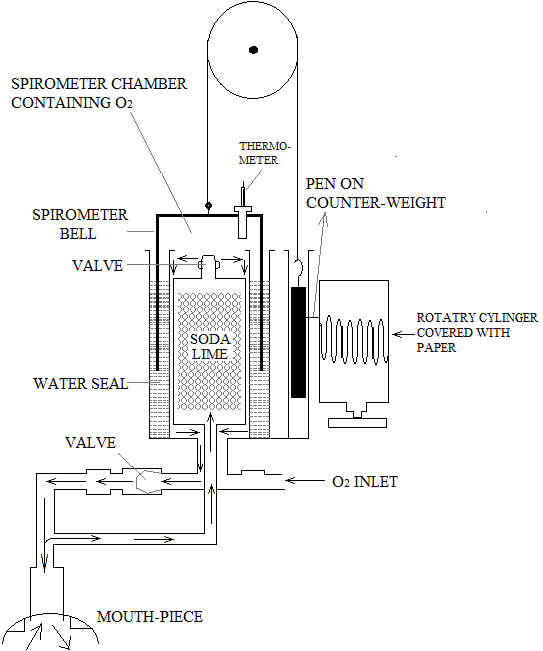Calculating Basal Metabolic Rate (BMR)
The term basal metabolic rate or BMR means the rate of energy expenditure under certain empirical circumstance known as basal conditions; it is expressed as Cals per square meter surface area of the body per hour. The basal conditions mean that an individual must not have taken any food within 14 hours, i.e. he is in post-absorptive state. He must be relaxed physically as well as mentally. He should be lying in a supine position. The environmental temperature should be in a comfortable range, i.e. around 70OF. The subject’s mind should not have any fears about the test. His body temperature should be recorded; preferably he should have a normal body temperature.
It has already been mentioned that for finding out the metabolic rate, two values, i.e. the amount of O2 consumed by the subject during a known period of time and his Respiratory quotient (R.Q) during this interval are to be determined. However, the determination of Respiratory quotient (R.Q) is not necessary for calculating Basal Metabolic Rate (BMR). This is because in a large number of experiments it was found out that the Respiratory quotient (R.Q) of a person under basal conditions in the post-absorptive state remains constant at 0.82. At this respiratory quotient (R.Q), 1 liter of O2 liberates 4.825 Cals.
Because the respiratory quotient (R.Q) of a person under basal conditions is 0.82 and the caloric value of 1 liter of O2 at this respiratory quotient (R.Q) is 4.825 Cals, total heat production can be easily determined even if only the amounts of O2 consumed per hour is known.
 Measurement of O2 Consumption
Measurement of O2 Consumption
The Benedict-Roth apparatus shown below (diagram form) is the most widely used apparatus for measuring O2 consumption. This method involves the closed circuit method of determining the metabolic rate.

 Calculation of Basal Metabolic Rate (BMR)
Calculation of Basal Metabolic Rate (BMR)
As already mentioned, it is assumed that the subject under experimental (basal) conditions has an Respiratory quotient (R.Q) of 0.82 at which 1 liter of O2 liberates 4.825 Cals. From the value of O2 consumed per hour obtained above, the number of Cals liberated per hour can be easily found out.
Since BMR is Cals/Square meter body surface area per hour, the surface area of the subject has also to be found out. For this purpose the height and weight of the subject is taken and the body surface area is found out by one of the following two methods.
![]() By using Dubois’s formula which is given below: Surface Area in Square centimeter = (Weight in Kg)0.425 x (Height in centimeter) 0.725 x 71.84 (a constant)
By using Dubois’s formula which is given below: Surface Area in Square centimeter = (Weight in Kg)0.425 x (Height in centimeter) 0.725 x 71.84 (a constant)
![]() By consulting the monogram given below:
By consulting the monogram given below:

The subject’s height and weight are marked on the vertical lines on the left and right respectively. The reading on the line in the center where the straight line joining these two points intersects gives the surface area.
Finally the number of Cals liberated by the subject per square meter body surface area per hour is calculated and the value obtained represents Basal Metabolic Rate (BMR)




